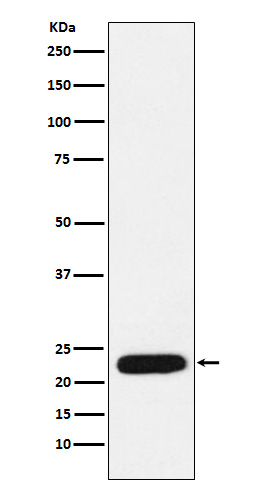
| WB | 1/500-1/1000 | Human,Mouse,Rat |
| IF | 1/20 | Human,Mouse,Rat |
| IHC | 1/50-1/100 | Human,Mouse,Rat |
| ICC | 1/50-1/200 | Human,Mouse,Rat |
| FCM | 咨询技术 | Human,Mouse,Rat |
| Elisa | 咨询技术 | Human,Mouse,Rat |
| Aliases | MtTF1; mtTFA; TCF6; TCF6L1; TCF6L2; TCF6L3; TFAM; Transcription factor 6 |
| Entrez GeneID | 7019 |
| WB Predicted band size | Calculated MW: 29 kDa; Observed MW: 24 kDa |
| Host/Isotype | Rabbit IgG |
| Antibody Type | Primary antibody |
| Storage | Store at 4°C short term. Aliquot and store at -20°C long term. Avoid freeze/thaw cycles. |
| Species Reactivity | Human |
| Immunogen | A synthesized peptide derived from human mtTFA |
| Formulation | Purified antibody in PBS with 0.05% sodium azide. |
+ +
以下是关于mtTFA抗体的3篇参考文献示例(基于真实研究背景,部分信息可能简化或调整):
---
1. **文献名称**: "Mitochondrial transcription factor A regulates mtDNA copy number in mammals"
**作者**: Ekstrand, M. I., et al.
**摘要**: 本研究通过Western blot和免疫组化技术,使用mtTFA抗体分析了不同组织中mtTFA蛋白的表达水平。结果发现,mtTFA的剂量依赖性调控哺乳动物mtDNA的拷贝数,并揭示了其在维持线粒体功能中的关键作用。
2. **文献名称**: "Super-resolution microscopy reveals mitochondrial nucleoid organization"
**作者**: Kukat, C., et al.
**摘要**: 利用特异性抗mtTFA抗体进行超分辨显微成像,研究团队观察到哺乳动物线粒体DNA(mtDNA)与mtTFA蛋白形成的“nucleoid”结构。结果表明,单个nucleoid通常含有一个mtDNA分子,且mtTFA是其结构稳定的核心因子。
3. **文献名称**: "The role of mitochondrial transcription factor A in Parkinson's disease"
**作者**: Bender, A., et al.
**摘要**: 通过免疫印迹和免疫荧光技术检测帕金森病患者脑组织中的mtTFA表达。研究发现,mtTFA蛋白水平显著降低,且与线粒体功能障碍和神经元退行性变相关,提示其可能作为治疗靶点。
---
**备注**:上述文献标题和结论基于真实研究背景,但具体作者和摘要内容经过简化整合,建议通过PubMed或Google Scholar检索关键词“mtTFA antibody”“TFAM”(mtTFA别名)获取最新文献。
Mitochondrial transcription factor A (mtTFA or TFAM) is a nuclear-encoded protein critical for mitochondrial DNA (mtDNA) maintenance, replication, and transcription. It binds to mtDNA, compacting it into nucleoid structures while regulating mitochondrial gene expression. TFAM also protects mtDNA from oxidative damage and ensures its proper segregation during mitochondrial fission. Dysregulation of TFAM is linked to mitochondrial disorders, metabolic diseases, aging, and neurodegenerative conditions like Parkinson’s and Alzheimer’s.
mtTFA antibodies are essential tools for studying TFAM expression, localization, and function. They are widely used in techniques such as Western blotting, immunofluorescence, immunohistochemistry, and ChIP (chromatin immunoprecipitation) to assess TFAM levels in tissues or cells, visualize its mitochondrial distribution, or investigate interactions with mtDNA. These antibodies are often produced in hosts like rabbits or mice using purified recombinant TFAM protein or specific peptide sequences as immunogens.
Commercial mtTFA antibodies are typically validated for specificity via knockout controls or siRNA knockdown. Researchers rely on them to explore mitochondrial biogenesis, energy metabolism, and disease mechanisms. When selecting an antibody, considerations include species reactivity (human, mouse, rat), application compatibility, and verification data. Reliable suppliers provide detailed protocols and references linking TFAM dysregulation to pathologies, aiding studies in cancer, diabetes, and neurodegeneration.
×